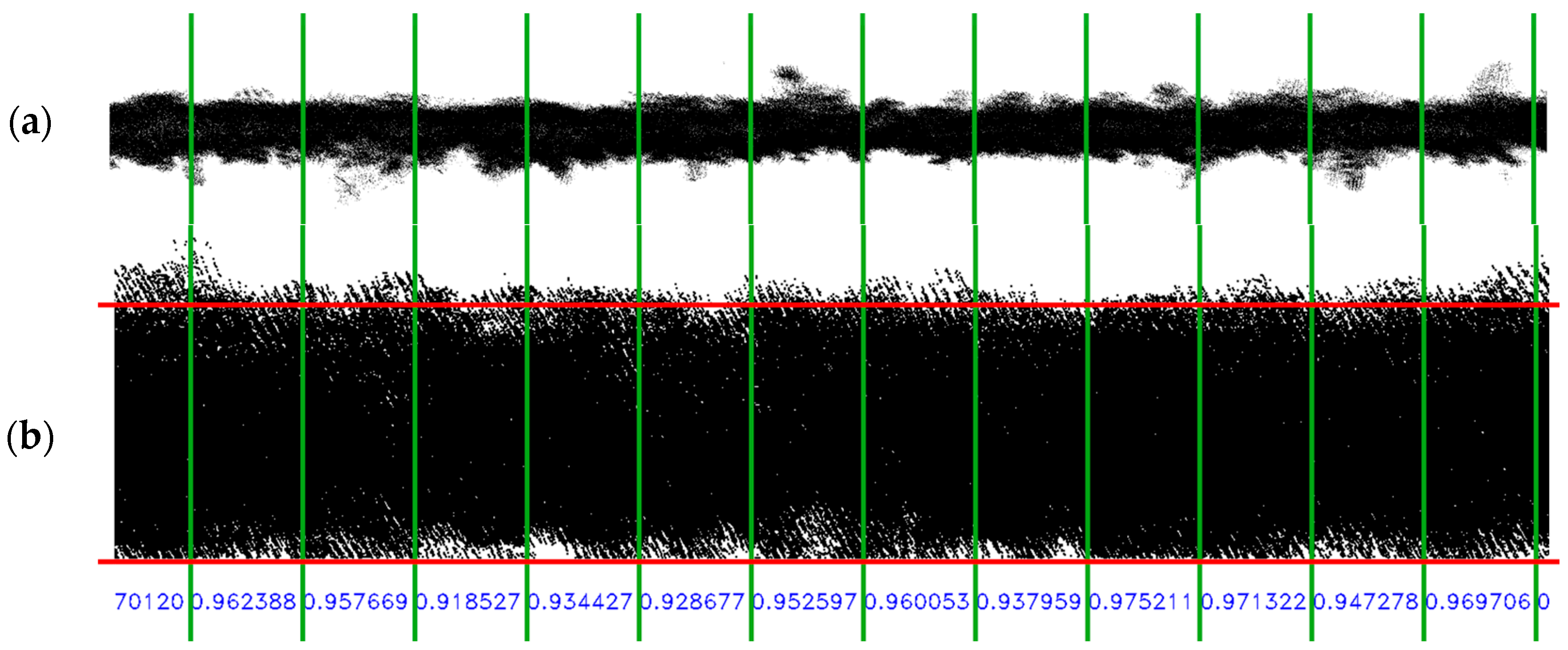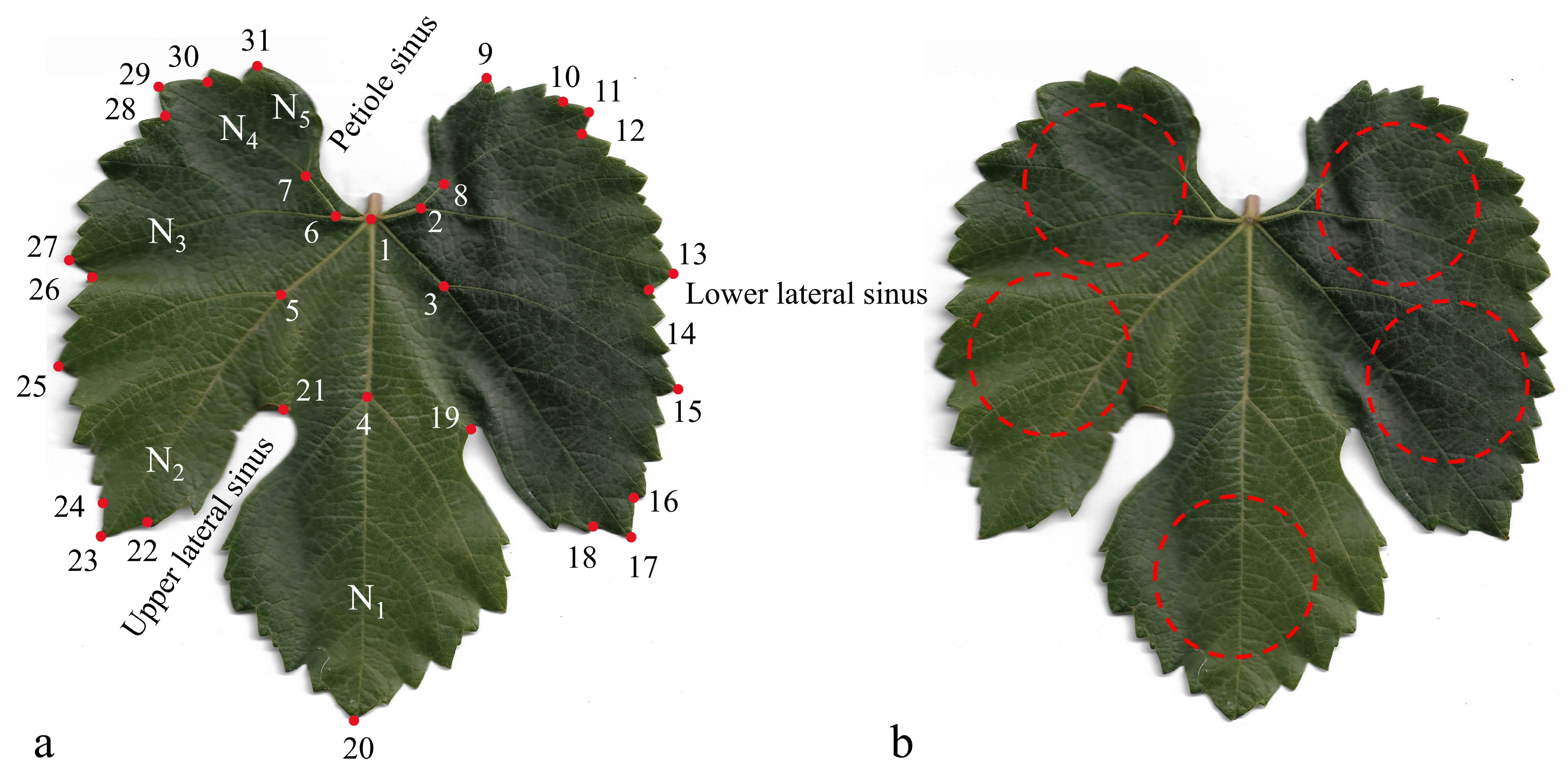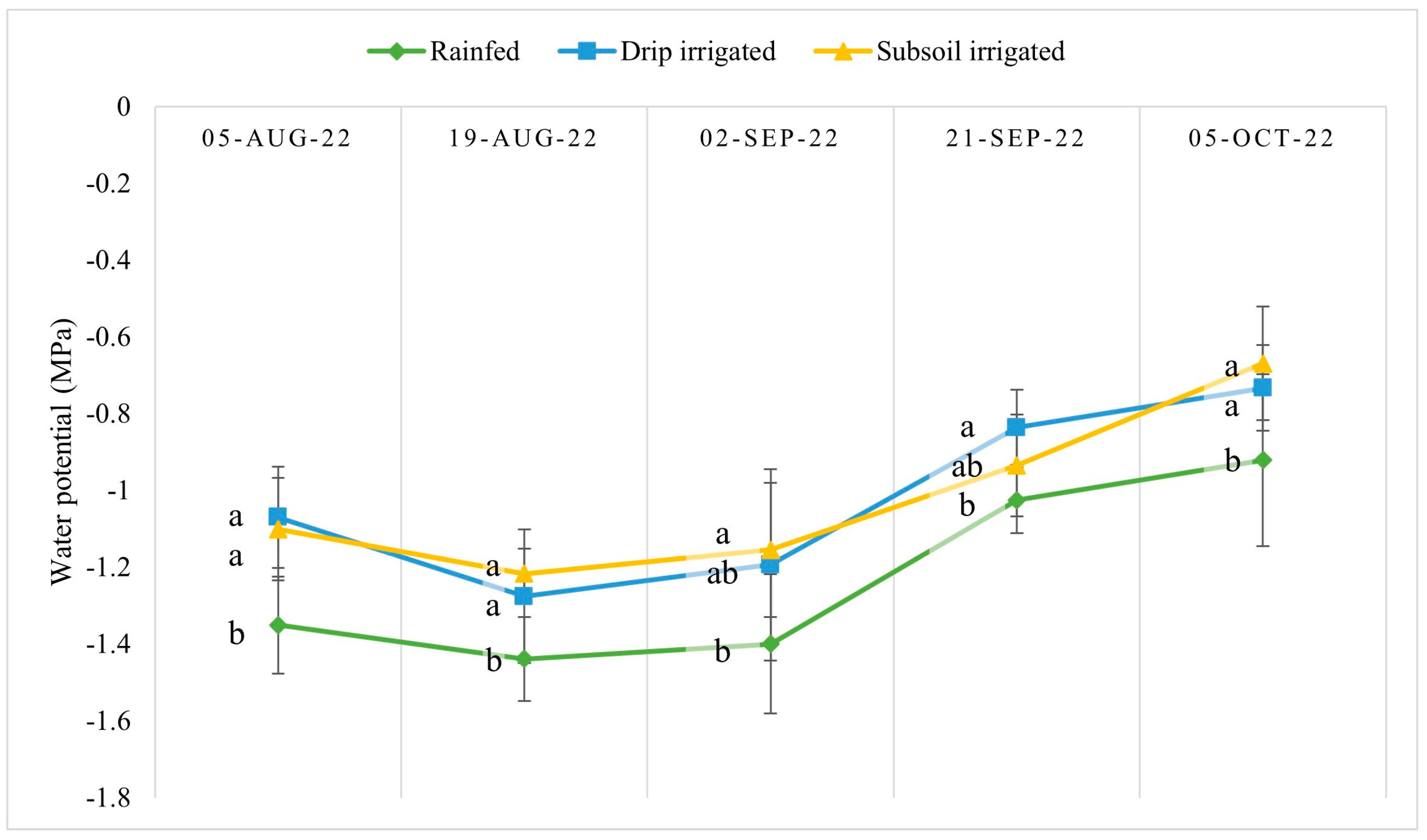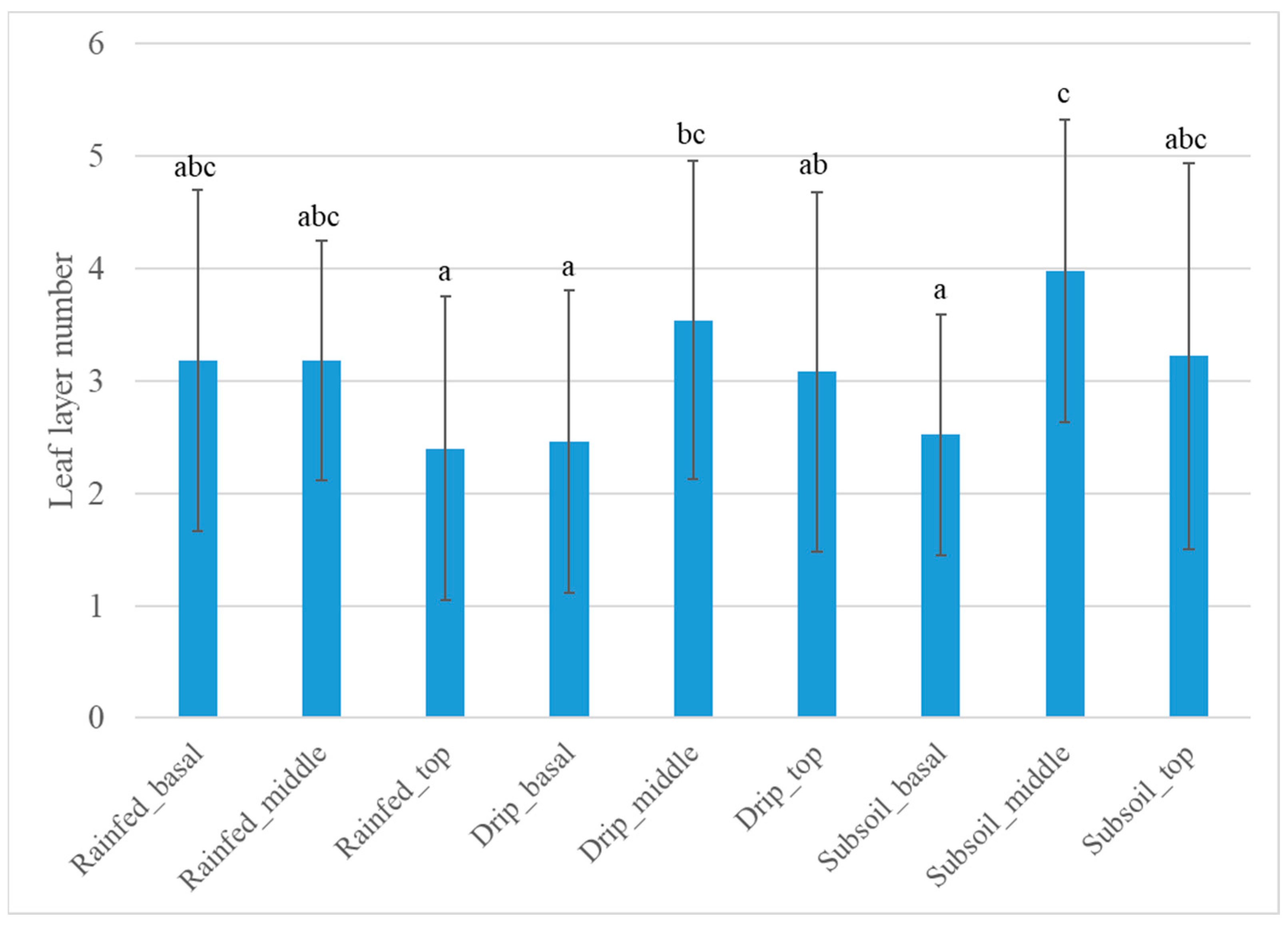The Effect of Irrigation on the Vineyard Canopy and Individual Leaf Morphology Evaluated with Proximal Sensing, Colorimetry, and Traditional Morphometry
Abstract
:1. Introduction
2. Materials and Methods
2.1. Experimental Vineyard and Irrigation
2.2. Water Potential Measurement
2.3. Canopy Structure Analysis
Point Quadrat Evaluation
2.4. LiDAR Record
2.4.1. Hardware
2.4.2. Measurements
2.4.3. Spatial FieldSLAM
2.5. Individual Leaf Morphology
2.5.1. Ampelometry
2.5.2. Leaf Colorimetry
2.6. Statistical Analysis
3. Results
3.1. Water Potential
3.2. Point Quadrat Measurement
3.3. LiDAR Monitoring of the Canopy
3.4. Individual Leaf Morphology
3.4.1. Ampelometry—OIV Descriptors
3.4.2. Ampelometry—Traditional Morphometry
| Treatment | Rainfed | Subsoil Irrigation | Drip Irrigation | |||||||
|---|---|---|---|---|---|---|---|---|---|---|
| Trait * | mean | st. dev. | OIV | mean | st. dev. | OIV | mean | st. dev. | OIV | |
| Surface, cm2 | 180.00 | 21.90 a | 208.78 | 30.31 b | 197.95 | 36.42 ab | ||||
| OIV 601 | Length of vein N1 | 119.78 | 15.97 | 3 | 127.10 | 13.10 | 5 | 118.86 | 17.10 | 3 |
| OIV 602R | Length of vein N2 | 99.44 | 9.43 a | 5 | 105.48 | 8.88 b | 5 | 102.21 | 10.56 ab | 5 |
| OIV 602L | 101.45 | 10.27 | 5 | 107.86 | 11.19 | 5 | 102.42 | 11.96 | 5 | |
| OIV 603R | Length of vein N3 | 74.91 | 5.10 a | 5 | 81.55 | 6.28 b | 5 | 80.63 | 8.05 b | 5 |
| OIV 603L | 75.91 | 6.18 | 5 | 81.26 | 7.38 | 5 | 80.64 | 7.62 | 5 | |
| OIV 604R | Length of vein N4 | 49.45 | 3.83 | 7 | 53.92 | 5.91 | 9 | 52.82 | 7.44 | 9 |
| OIV 604L | 49.92 | 5.31 a | 7 | 54.97 | 6.50 b | 9 | 52.79 | 6.04 ab | 9 | |
| OIV 605R | Length of petiole sinus to upper lateral leaf sinus | 84.27 | 9.59 | 7 | 87.49 | 8.84 | 7 | 88.01 | 12.15 | 7 |
| OIV 605L | 84.82 | 11.17 a | 7 | 91.16 | 7.38 b | 7 | 88.58 | 11.31 ab | 7 | |
| OIV 606R | Length of petiole sinus to lower lateral leaf sinus | 67.40 | 4.70 a | 5 | 74.13 | 5.26 b | 7 | 72.65 | 7.01 b | 7 |
| OIV 606L | 69.26 | 5.70 | 7 | 73.86 | 6.84 | 7 | 73.21 | 6.72 | 7 | |
| OIV 611R | Length of vein N5 | 17.96 | 4.48 | 1 | 19.12 | 7.04 | 1 | 19.46 | 4.59 | 1 |
| OIV 611L | 18.44 | 5.05 | 1 | 19.98 | 5.60 | 1 | 18.27 | 4.40 | 1 | |
| OIV 612R | Length of tooth N2 | 16.89 | 32.65 | 5 | 8.19 | 2.10 | 3 | 7.21 | 1.70 | 3 |
| OIV 612L | 8.40 | 2.70 | 3 | 8.97 | 5.78 | 3 | 7.64 | 2.05 | 3 | |
| OIV 613R | Width of tooth N2 | 15.30 | 2.17 | 5 | 15.68 | 3.50 | 5 | 14.16 | 2.35 | 5 |
| OIV 613L | 15.11 | 3.63 | 5 | 16.88 | 9.55 | 5 | 14.98 | 3.11 | 5 | |
| OIV 614R | Mature leaf: length of tooth N4 | 7.40 | 2.13 | 1 | 6.87 | 1.33 | 1 | 7.19 | 1.36 | 1 |
| OIV 614L | 6.78 | 1.47 | 1 | 7.70 | 1.79 | 1 | 7.12 | 1.49 | 1 | |
| OIV 615R | Width of tooth N4 | 12.76 | 3.75 | 5 | 12.21 | 1.78 | 5 | 12.57 | 2.05 | 5 |
| OIV 615L | 11.65 | 2.29 | 3 | 12.87 | 2.58 | 5 | 12.61 | 2.30 | 5 | |
| OIV 617R | Length between the tooth tip of N2 and the tooth tip of the first secondary vein of N2 | 46.41 | 9.97 | 5 | 47.05 | 6.44 | 5 | 45.46 | 7.35 | 5 |
| OIV 617L | 45.84 | 8.84 | 5 | 49.58 | 9.45 | 5 | 44.71 | 8.34 | 3 | |
| OIV 618R | Distance between the tooth tips of N4 | 86.87 | 13.73 | 98.88 | 11.76 | 93.43 | 12.46 | |||
| OIV 618L | Distance between the tooth tips of N5 | 21.68 | 8.18 | 25.16 | 11.03 | 23.29 | 11.36 | |||
| OIV 607R | Angle between the tip of N1 and the tangent between petiole point and the first branch of the N2 | 57.81 | 8.31 | 7 | 57.41 | 6.31 | 7 | 60.37 | 7.28 | 7 |
| OIV 607L | 57.30 | 6.06 | 7 | 56.61 | 6.94 | 7 | 59.48 | 5.38 | 7 | |
| OIV 608R | Angle between N2 and N3 measured on the tangents formed before these veins first branch | 60.17 | 5.57 | 7 | 61.16 | 8.85 | 7 | 58.15 | 5.97 | 7 |
| OIV 608L | 59.81 | 6.89 | 7 | 57.70 | 5.76 | 7 | 57.25 | 6.70 | 7 | |
| OIV 609R | Angle between the tooth tip of N3 and the tangent between the first branch of N3 and the tooth tip of N4 | 51.39 | 4.56 | 5 | 50.10 | 5.52 | 5 | 50.73 | 4.03 | 5 |
| OIV 609L | 50.52 | 7.51 | 5 | 49.88 | 6.76 | 5 | 50.23 | 5.45 | 5 | |
| OIV 610R | Angle between the tooth tip of N3 and the tangent between the petiole point and the tooth tip of N5 | 73.67 | 9.05 | 9 | 72.02 | 9.87 | 9 | 68.56 | 8.30 | 7 |
| OIV 610L | 71.30 | 9.33 | 9 | 69.69 | 9.76 | 7 | 70.26 | 8.28 | 9 | |
| OIV 618aR | Angle between the tooth tip of N5 and the tangent between the petiole point and the tooth tip of N5 | 93.07 | 15.48 | 96.41 | 12.22 | 92.59 | 14.25 | |||
| OIV 618aL | Angle between the tooth tip of N4 and the tangent between the petiole point and the tooth tip of N4 | 34.24 | 14.46 | 37.38 | 15.58 | 36.27 | 17.09 | |||
| D 01-02 | Distance between the points 01 and 02 | 11.06 | 2.49 a | 13.63 | 3.29b | 13.76 | 2.90 b | |||
| D 01-03 | Distance between the points 01 and 03 | 23.83 | 3.35 a | 26.76 | 4.59b | 24.34 | 2.30 b | |||
| D 01-04 | Distance between the points 01 and 04 | 33.74 | 7.40 ab | 37.86 | 8.16b | 31.78 | 6.86 a | |||
| D 01-05 | Distance between the points 01 and 05 | 25.46 | 3.98 | 27.01 | 3.84 | 26.44 | 4.29 | |||
| D 01-06 | Distance between the points 01 and 06 | 11.37 | 3.18 | 12.64 | 3.66 | 13.12 | 2.62 | |||
| D 01-31 | Distance between the points 01 and 31 | 34.17 | 5.66 | 36.93 | 7.52 | 34.06 | 6.97 | |||
| D 01-09 | Distance between the points 01 and 09 | 32.17 | 6.42 | 36.08 | 7.80 | 35.71 | 6.32 | |||
| D 01-29 | Distance between the points 01 and 29 | 60.66 | 6.38 a | 66.83 | 7.40 b | 65.11 | 5.24 ab | |||
| D 01-11 | Distance between the points 01 and 11 | 59.80 | 4.36 a | 66.81 | 6.64 ab | 65.76 | 7.38 b | |||
| D 27-13 | Distance between the points 27 and 13 | 149.91 | 10.13 | 161.96 | 11.72 | 160.49 | 13.94 | |||
| D 25-15 | Distance between the points 25 and 15 | 154.73 | 12.24 a | 166.58 | 15.52 b | 164.46 | 15.12 b | |||
| D 23-17 | Distance between the points 23 and 17 | 135.70 | 11.87 a | 147.71 | 16.30 b | 146.91 | 16.50 ab | |||
| D 11-13 | Distance between the points 11 and 13 | 51.71 | 5.51 | 54.78 | 7.60 | 53.95 | 7.86 | |||
| D 13-17 | Distance between the points 13 and 17 | 74.40 | 11.45 | 76.66 | 8.41 | 74.85 | 11.47 | |||
| D 17-20 | Distance between the points 17 and 20 | 83.56 | 10.05 a | 91.52 | 11.47b | 89.83 | 12.88 b | |||
| D 20-23 | Distance between the points 20 and 23 | 81.12 | 9.93 | 88.24 | 12.42 | 87.33 | 13.62 | |||
| D 23-27 | Distance between the points 23 and 27 | 74.61 | 11.16 | 78.32 | 11.85 | 74.40 | 12.42 | |||
| D 27-29 | Distance between the points 27 and 29 | 51.85 | 8.44 | 54.29 | 8.09 | 53.76 | 9.42 | |||
3.4.3. Colorimetry
| Subsoil | Drip Irrigation | Rainfed | ||||
|---|---|---|---|---|---|---|
| Index | mean | st. dev. | mean | st. dev. | mean | st. dev. |
| L* | 28.32 | 2.48 a | 29.30 | 2.16 b | 29.24 | 2.84 b |
| a* | −8.36 | 1.76 b | −7.38 | 1.49 a | −8.61 | 1.66 b |
| b* | 9.77 | 2.89 b | 5.97 | 2.25 a | 10.62 | 3.42 c |
| Chroma | 12.88 | 3.31 b | 9.53 | 2.56 a | 13.71 | 3.66 b |
| Hue | 179.15 | 0.05 b | 179.34 | 0.09 c | 179.12 | 0.06 a |
| R | 59.38 | 5.11 a | 60.80 | 4.28 ab | 61.56 | 6.33 b |
| G | 70.17 | 6.20 a | 72.18 | 5.45 b | 72.38 | 7.00 b |
| B | 51.03 | 2.82 a | 59.08 | 2.11 b | 51.69 | 3.34 a |
| SAVI | 0.12 | 0.02 ab | 0.13 | 0.02 b | 0.12 | 0.02 a |
| r | 0.33 | 0.01 c | 0.32 | 0.00 a | 0.33 | 0.01 b |
| g | 0.39 | 0.01 b | 0.38 | 0.01 a | 0.39 | 0.01 b |
| b | 0.28 | 0.01 b | 0.31 | 0.01 a | 0.28 | 0.02 c |
| R−G | −10.80 | 2.17 b | −11.39 | 1.82 a | −10.83 | 1.92 b |
| R−B | 8.35 | 3.91 b | 1.72 | 2.80 a | 9.87 | 5.36 c |
| G−B | 19.14 | 5.41 b | 13.10 | 4.21 a | 20.69 | 6.27 c |
| (R−G)/(R+G) | −0.08 | 0.01 ab | −0.09 | 0.01 a | −0.08 | 0.01 b |
| (R−B)/(R+B) | 0.07 | 0.03 b | 0.01 | 0.02 a | 0.09 | 0.04 c |
| (G−R)/(G+R) | 0.08 | 0.01 ab | 0.09 | 0.01 b | 0.08 | 0.01 a |
| (G−B)/(G+B) | 0.16 | 0.04 b | 0.10 | 0.03 a | 0.17 | 0.04 b |
| (R−G)/(R+G+B) | −0.06 | 0.01 | −0.06 | 0.01 | −0.06 | 0.01 |
| (R−B)/(R+G+B) | 0.05 | 0.02 b | 0.01 | 0.01 a | 0.05 | 0.02 c |
| (G−B)/(R+G+B) | 0.11 | 0.02 b | 0.07 | 0.02 a | 0.11 | 0.03 b |
| RGRI | 0.85 | 0.03 ab | 0.84 | 0.02 a | 0.85 | 0.02 b |
| GLI | 0.12 | 0.02 b | 0.09 | 0.02 a | 0.12 | 0.02 b |
| VARI | 0.14 | 0.02 b | 0.15 | 0.02 a | 0.13 | 0.02 b |
| IPCA | 36.56 | 10.44 b | 24.70 | 8.11 a | 39.58 | 12.17 c |
| ExR | −0.08 | 0.02 | −0.08 | 0.01 | −0.08 | 0.01 |
| ExB | −0.15 | 0.03 b | −0.09 | 0.03 a | −0.15 | 0.04 b |
| ExG | −0.69 | 0.02 b | −0.73 | 0.02 a | −0.68 | 0.03 c |
| ExGR | −0.60 | 0.02 b | −0.65 | 0.02 a | −0.59 | 0.03 c |
| Gray | 0.36 | 0.01 | 0.35 | 0.00 | 0.36 | 0.01 |
| CIVE | 18.72 | 0.01 | 18.73 | 0.01 | 18.72 | 0.01 |
4. Discussion
5. Conclusions
Author Contributions
Funding
Data Availability Statement
Acknowledgments
Conflicts of Interest
References
- Chaves, M.M.; Zarrouk, O.; Francisco, R.; Costa, J.M.; Santos, T.; Regalado, A.P.; Rodrigues, M.L.; Lopes, C.M. Grapevine under deficit irrigation: Hints from physiological and molecular data. Ann. Bot. 2010, 105, 661–676. [Google Scholar] [CrossRef] [PubMed]
- Van Leeuwen, C.; Trégoat, O.; Choné, X.; Bois, B.; Pernet, D.; Gaudillère, J.P. Vine water status is a key factor in grape ripening and vintage quality for red Bordeaux wine. How can it be assessed for vineyard management purposes? Oeno ONE 2009, 43, 121–134. [Google Scholar] [CrossRef]
- Kozma, P. A Szőlő és Termesztése; Akadémiai Kiadó: Budapest, Hungary, 1993. [Google Scholar]
- Esteban, M.A.; Villanueva, M.J.; Lissarrague, J.R. Effect of irrigation on changes in the anthocyanin composition of the skin of cv Tempranillo (Vitis vinifera L.) grape berries during ripening. J. Sci. Food Agric. 2001, 81, 409–420. [Google Scholar] [CrossRef]
- Acevedo-Opazo, C.; Ortega-Farias, S.; Fuentes, S. Effects of grapevine (Vitis vinifera L.) water status on water consumption, vegetative growth and grape quality: An irrigation scheduling application to achieve regulated deficit irrigation. Agric. Water Manag. 2010, 97, 956–964. [Google Scholar] [CrossRef]
- Hamman, R.A.; Dami, I.E. Effects of irrigation on wine grape growth and fruit quality. HortTechnology 2000, 10, 162–168. [Google Scholar] [CrossRef]
- OIV. Descriptor List for Grape Varieties and Vitis Species, 2nd ed.; Office International de la Vigne et du Vin: Paris, France, 2009; p. 177. [Google Scholar]
- Ravaz, L. Les Vignes Americaines: Porte-Greffes et Producteurs Directs (Caracteres Aptitudes); Coulet et Fils, Éditeurs: Montpellier, France, 1902; p. 390. [Google Scholar]
- Galet, P. Méthode de Description et de Classification des Espécies Variétés et Hybrids de Vignes; Imprimerie Paul Déhan: Montpellier, France, 1951; p. 8. [Google Scholar]
- Chitwood, D.H.; Rundell, S.M.; Li, D.Y.; Woodford, Q.L.; Yu, T.T.; Lopez, J.R.; Greenblatt, D.; Kang, J.; Londo, J.P. Climate and developmental plasticity: Interannual variability in grapevine leaf morphology. Plant Physiol. 2016, 170, 1480–1491. [Google Scholar] [CrossRef] [PubMed]
- Bodor-Pesti, P.; Taranyi, D.; Nyitrainé Sárdy, D.Á.; Le Phuong Nguyen, L.; Baranyai, L. Correlation of the Grapevine (Vitis vinifera L.) Leaf Chlorophyll Concentration with RGB Color Indices. Horticulturae 2023, 9, 899. [Google Scholar] [CrossRef]
- Fuentes, S.; Hernández-Montes, E.; Escalona, J.M.; Bota, J.; Viejo, C.G.; Poblete-Echeverría, C.; Medrano, H. Automated grapevine cultivar classification based on machine learning using leaf morpho-colorimetry, fractal dimension and near-infrared spectroscopy parameters. Comput. Electron. Agric. 2018, 151, 311–318. [Google Scholar] [CrossRef]
- Sang, W.G.; Kim, J.H.; Baek, J.K.; Kwon, D.; Ban, H.Y.; Cho, J.I.; Seo, M.C. Detection of drought stress in soybean plants using RGB-based vegetation indices. Korean J. Agric. For. Meteorol. 2021, 23, 340–348. [Google Scholar] [CrossRef]
- Bodor, P.; Baranyai, L.; Ladányi, M.; Bálo, B.; Strever, A.E.; Bisztra, G.D.; Hunter, J.J. Stability of ampelometric characteristics of Vitis vinifera L. cv. ‘Syrah’ and ‘Sauvignon blanc” leaves: Impact of within-vineyard variability and pruning method/bud load. S. Afr. J. Enol. Vitic. 2013, 34, 129–137. [Google Scholar] [CrossRef]
- Intrieri, C.; Poni, S.; Lia, G.; Campo, M.D. Vine performance and leaf physiology of conventionally and minimally pruned Sangiovese grapevines. Vitis 2001, 40, 123–130. [Google Scholar]
- Bodor, P.; Baranyai, L.; Parrag, V.; Bisztray, G.D. Effect of row orientation and elevation on leaf morphology of grapevine (Vitis vinifera L.) c.v. Furmint. Progr. Agric. Eng. Sci. 2014, 10, 53–69. [Google Scholar] [CrossRef]
- Gómez-del-Campo, M.; Ruiz, C.; Lissarrague, J.R. Effect of water stress on leaf area development, photosynthesis, and productivity in Chardonnay and Airén grapevines. Am. J. Enol. Vitic. 2002, 53, 138–143. [Google Scholar] [CrossRef]
- Sabir, A. Physiological and morphological responses of grapevine (V. vinifera L. cv. ‘Italia’) leaf to water deficit under different rootstock effects. Acta Sci. Polonorum. Hortorum Cultus 2016, 15, 135–148. [Google Scholar] [CrossRef]
- Ates, F.; Kaya, O. The relationship between iron and nitrogen concentrations based on Kjeldahl method and SPAD-502 readings in grapevine (Vitis vinifera L. cv.‘Sultana Seedless’). Erwerbs-Obstbau 2021, 63, 53–59. [Google Scholar] [CrossRef]
- Casanova-Gascón, J.; Martín-Ramos, P.; Martí-Dalmau, C.; Badía-Villas, D. Nutrients assimilation and chlorophyll contents for different grapevine varieties in calcareous soils in the Somontano DO (Spain). Beverages 2018, 4, 90. [Google Scholar] [CrossRef]
- Pavlousek, P. Evaluation of drought tolerance of new grapevine rootstock hybrids. J. Environ. Biol. 2011, 32, 543. [Google Scholar]
- Gutiérrez-Gamboa, G.; Zheng, W.; de Toda, F.M. Current viticultural techniques to mitigate the effects of global warming on grape and wine quality: A comprehensive review. Food Res. Int. 2021, 139, 109946. [Google Scholar] [CrossRef]
- Williams, L.E.; Araujo, F.J. Correlations among predawn leaf, midday leaf, and midday stem water potential and their correlations with other measures of soil and plant water status in Vitis vinifera. J. Am. Soc. Hortic. Sci. 2002, 127, 448–454. [Google Scholar] [CrossRef]
- Smart, R.E.; Dick, J.K.; Gravett, I.M.; Fisher, B.M. Canopy management to improve grape yield and wine quality-principles and practices. S. Afr. J. Enol. Vitic. 1990, 11, 3–17. [Google Scholar] [CrossRef]
- Hammer, Ø.; Harper, D.A. Past: Paleontological statistics software package for educaton and data anlysis. Palaeontol. Electron. 2001, 4, 1. [Google Scholar]
- Lepej, P.; Rakun, J. Simultaneous localisation and mapping in a complex field environment. Biosyst. Eng. 2016, 150, 160–169. [Google Scholar] [CrossRef]
- Bodor, P.; Baranyai, L.; Bálo, B.; Tóth, E.; Strever, A.E.; Hunter, J.J.; Bisztray, G.D. GRA. LE. D.(GRApevine LEaf Digitalization) Software for the Detection and Graphic Reconstruction of Ampelometric Differences between Vitis leaves. S. Afr. J. Enol. Vitic. 2012, 33, 1–6. [Google Scholar] [CrossRef]
- Abràmoff, M.D.; Magalhães, P.J.; Ram, S.J. Image processing with ImageJ. Biophotonics Int. 2004, 11, 36–42. [Google Scholar] [CrossRef]
- Pazda, A.D.; Thorstenson, C.A. Color intensity increases perceived extraversion and openness for zero-acquaintance judgments. Personal. Individ. Differ. 2019, 147, 118–127. [Google Scholar] [CrossRef]
- Sánchez-Sastre, L.F.; Alte da Veiga, N.M.S.; Ruiz-Potosme, N.M.; Carrión-Prieto, P.; Marcos-Robles, J.L.; Navas-Gracia, L.M.; Martín-Ramos, P. Assessment of RGB Vegetation Indices to Estimate Chlorophyll Content in Sugar Beet Leaves in the Final Cultivation Stage. AgriEngineering 2020, 2, 128–149. [Google Scholar] [CrossRef]
- OMSZ. Hungarian Meteorological Service. 2024. Available online: https://www.met.hu/ (accessed on 10 April 2024).
- Taranyi, D.; Mikóczy, N.; Deák, T.; Varga, Z.; Nyitrainé Sárdy, D.A.; Bodor-Pesti, P. The effect of irrigation on the bud fruitfulness of the grapevine (Vitis vinifera L.) cultivar ‘Hárslevelű’. Acta Hortic. 2024, 1385, 175–180. [Google Scholar] [CrossRef]
- Deloire, A.; Pellegrino, A.; Rogiers, S. A few words on grapevine leaf water potential. IVES Tech. Rev. Vine Wine 2020. [CrossRef]
- de Azevedo, P.V.; Soares, J.M.; da Silva, V.D.P.R.; da Silva, B.B.; Nascimento, T. Evapotranspiration of “Superior” grapevines under intermittent irrigation. Agric. Water Manag. 2008, 95, 301–308. [Google Scholar] [CrossRef]
- Flexas, J.; Galmés, J.; Gallé, A.; Gulías, J.; Pou, A.; Ribas-Carbo, M.; Tomàs, M.; Medrano, H. Improving water use efficiency in grapevines: Potential physiological targets for biotechnological improvement. Aust. J. Grape Wine Res. 2010, 16, 106–121. [Google Scholar] [CrossRef]
- Fasiolo, D.T.; Pichierri, A.; Sivilotti, P.; Scalera, L. An analysis of the effects of water regime on grapevine canopy status using a UAV and a mobile robot. Smart Agric. Technol. 2023, 6, 100344. [Google Scholar] [CrossRef]
- Castellarin, S.D.; Pfeiffer, A.; Sivilotti, P.; Degan, M.; Peterlunger, E.; Di Gaspero, G. Transcriptional regulation of anthocyanin biosynthesis in ripening fruits of grapevine under seasonal water deficit. Plant Cell Environ. 2007, 30, 1381–1399. [Google Scholar] [CrossRef] [PubMed]
- Briglia, N.; Montanaro, G.; Petrozza, A.; Summerer, S.; Cellini, F.; Nuzzo, V. Drought phenotyping in Vitis vinifera using RGB and NIR imaging. Sci. Hortic. 2019, 256, 108555. [Google Scholar] [CrossRef]
- Romero, P.; Martinez-Cutillas, A. The effects of partial root-zone irrigation and regulated deficit irrigation on the vegetative and reproductive development of field-grown Monastrell grapevines. Irrig. Sci. 2012, 30, 377–396. [Google Scholar] [CrossRef]
- Preinier, D.; Safner, T.; Karoglan Kontić, J.; Marković, Z.; Šimon, S.; Maletić, E. Analysis of phyllometric parameters efficiency in discrimination of Croatian native V. vinifera cultivars. Vitis 2014, 53, 215–217. [Google Scholar] [CrossRef]
- Benítez, H.A.; Lemic, D.; Villalobos-Leiva, A.; Bažok, R.; Órdenes-Claveria, R.; Pajač Živković, I.; Mikac, K.M. Breaking symmetry: Fluctuating asymmetry and geometric morphometrics as tools for evaluating developmental instability under diverse agroecosystems. Symmetry 2020, 12, 1789. [Google Scholar] [CrossRef]
- Cheng, L.; Zhu, X.; Gao, L.; Li, C.; Wang, L.; Zhao, G.; Jiang, Y. Estimation of chlorophyll content in apple leaves based on RGB model using digital camera. Acta Hortic. Sin. 2017, 44, 381–390. [Google Scholar] [CrossRef]
- Jiao, S.; Zeng, F.; Huang, Y.; Zhang, L.; Mao, J.; Chen, B. Physiological, biochemical and molecular responses associated with drought tolerance in grafted grapevine. BMC Plant Biol. 2023, 23, 110. [Google Scholar] [CrossRef]





Disclaimer/Publisher’s Note: The statements, opinions and data contained in all publications are solely those of the individual author(s) and contributor(s) and not of MDPI and/or the editor(s). MDPI and/or the editor(s) disclaim responsibility for any injury to people or property resulting from any ideas, methods, instructions or products referred to in the content. |
© 2024 by the authors. Licensee MDPI, Basel, Switzerland. This article is an open access article distributed under the terms and conditions of the Creative Commons Attribution (CC BY) license (https://creativecommons.org/licenses/by/4.0/).
Share and Cite
Lepej, P.; Taranyi, D.; Rakun, J.; Nagy, B.; Steckl, S.; Lukácsy, G.; Mikóczy, N.; Nyitrainé Sárdy, D.Á.; Bodor-Pesti, P. The Effect of Irrigation on the Vineyard Canopy and Individual Leaf Morphology Evaluated with Proximal Sensing, Colorimetry, and Traditional Morphometry. Horticulturae 2024, 10, 716. https://doi.org/10.3390/horticulturae10070716
Lepej P, Taranyi D, Rakun J, Nagy B, Steckl S, Lukácsy G, Mikóczy N, Nyitrainé Sárdy DÁ, Bodor-Pesti P. The Effect of Irrigation on the Vineyard Canopy and Individual Leaf Morphology Evaluated with Proximal Sensing, Colorimetry, and Traditional Morphometry. Horticulturae. 2024; 10(7):716. https://doi.org/10.3390/horticulturae10070716
Chicago/Turabian StyleLepej, Peter, Dóra Taranyi, Jurij Rakun, Balázs Nagy, Szabina Steckl, György Lukácsy, Nárcisz Mikóczy, Diána Ágnes Nyitrainé Sárdy, and Péter Bodor-Pesti. 2024. "The Effect of Irrigation on the Vineyard Canopy and Individual Leaf Morphology Evaluated with Proximal Sensing, Colorimetry, and Traditional Morphometry" Horticulturae 10, no. 7: 716. https://doi.org/10.3390/horticulturae10070716









